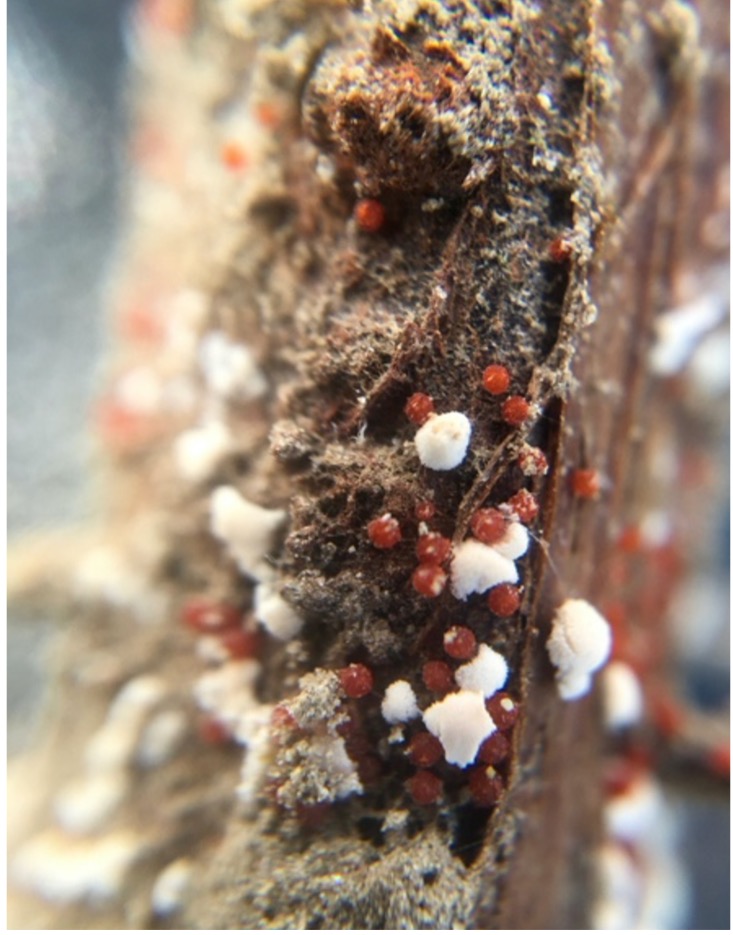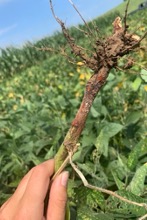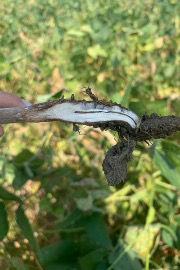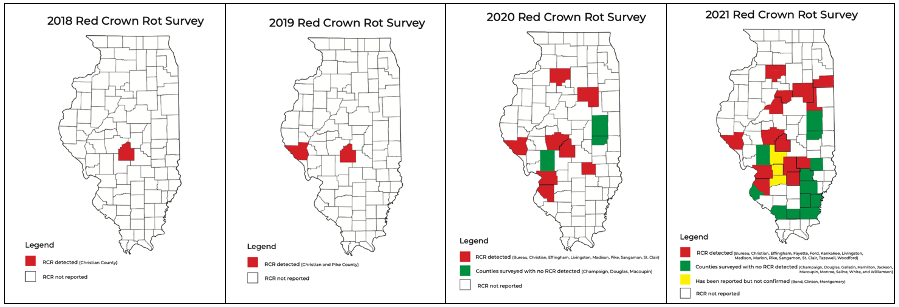Introduction
Red crown rot (RCR) of soybean is caused by the soilborne fungus Calonectria ilicicola. Occurrence of RCR was first reported on soybean in the United States in 1972 (Kim et al. 2001). RCR causes pre- and post-emergence damping off in soybean as well as root rot and foliar chlorosis and necrosis after flowering. Infected plants die prematurely, reducing overall yield (Akamatsu et al. 2020). The fungus is also known to infect peanuts causing the disease known as Cylindrocladium black rot, which occurs more commonly in poorly drained soils (Anco and Chapin 2016).
RCR has been reported in Alabama, Arkansas, Georgia, Illinois, Louisiana, Mississippi, Missouri, North Carolina, South Carolina, Texas, and Virginia, as well as in Asia and Australia (Kleczewski et al. 2019; Padgett et al. 2015). In Illinois, RCR was first observed in a commercial soybean field in Pike County in 2018 and was confirmed in 2019. The Pike County field was estimated to have disease incidence at 75 percent (Kleczewski et al. 2019). In September 2021, RCR was found in Kentucky. Red crown rot has not been reported in Iowa, Indiana, or Wisconsin.
Diagnosing RCR – Signs and Symptoms
Plants may become infected with the fungus soon after planting, resulting in seedling damping off and early root rot. Later in the season, symptoms of RCR are most noticeable when, from a distance, the disease looks like SDS or possible other diseases due to leaf inter-veinal chlorosis and necrosis. The foliar symptom phase of RCR can be visually similar to sudden death syndrome in that the fungus infects and colonizes roots and produces a toxin that moves in the vascular system to the leaves causing chlorosis and necrosis (Yamamoto et al. 2017), however leaves turn yellow from the lower stem upward to the top of the plant. On maturing infected plants, a reddish discoloration, often with perithecia, can be observed around the lower stem (Fig. 1). Infected roots will be rotted, plants can be easily pulled from the soil (Fig. 2), and the inside of the stem may have a gray discoloration (Fig. 3) (Yamamoto et al. 2017). RCR may appear more frequently in warm, humid, and moist environments.
Occurrence of RCR on soybean in Illinois
Since the disease was first found and confirmed (Kleczewski et al. 2019), efforts to monitor the disease in Illinois, including field surveys, cooperation with the University of Illinois Plant Clinic and Extension, and direct request of samples from farmers, have resulted in maps of RCR occurrence from 2018 to 2021 (Fig. 4). In 2020, plants in fields in eight counties were identified with RCR. In 2021, six additional counties were added. In total, there are 14 positive confirmed counties in Illinois, including Bureau, Christian, Effingham, Fayette, Ford, Kankakee, Livingston, Madison, Marion, Pike, Sangamon, St. Clair, Tazewell, Woodford counties. Not presented on the 2021 map, Bond, Clinton, and Montgomery counties may have fields with RCR based on observations but not sample verifications.
RCR Management
Studies in Illinois have not been completed to determine the “best” management practices for red crown rot. The literature indicates that a rotation of grain crops (non-legume), delayed planting to avoid wet soils, and tillage may be effective (Akamatsu et al. 2020). Other literature indicates that the disease is difficult to manage because of its wide host range and its longevity in soil (Jiang et al. 2020.)
References
Akamatsu, H., Fujii, N., Saito, T., Sayama, A., Matsuda, H., Kato, M., Kowada, R., Yasuta, Y., Igarashi, Y., Komori, H., Tanji, K., Kuroda, T., Fujita, Y., Hattori, M., Kawakami, O., Hori, T., Mimuro, G., Morikawa, T., Murasaki, N., Aoki, Y., Sekihara, J., Iyama, Y., Nakada, H., Iwata, T., Kichishima, T., Ebitani, T., Numada, F., Manta, H., Nakajima, H., Yamashita, T., Miyahara, K., Toyoshima, G., Yamada, K., Yamamoto, R., Ochi, S. (2020). Factors affecting red crown rot caused by Calonectria ilicicola in soybean cultivation. J. Gen. Plant Pathol. 86:363–375.
Anco, D., and Chapin, J.W. (2016). South Carolina Pest Management Handbook for Field Crops. Clemson Cooperative Extension Service.
Jiang, C. J., Sugano, S., Ochi, S., Kaga, A., and Ishimoto, M. (2020). Evaluation of Glycine max and Glycine soja for resistance to Calonectria ilicicola. Agronomy, 10(6), 887. https://doi.org/10.3390/agronomy10060887
Kim, K.D., Russin, J.S., and Snow, J.P. (1998). Susceptibility to Calonectria ilicicola in soybean growth in greenhouse and field. Korean J. Crop. Sci. 43:239–244.
Kleczewski, N., Plewa, D., Kangas, C., Philippi, E., and Kleczewski, V. (2019). First report of red crown rot of soybeans caused by Calonectria ilicicola (Anamorph: Cylindroclaidum parasiticum) in Illinois. Plant Disease 103:1777.
Yamamoto, R., Nakagawa, A., Shimada, S., Komatsu, S., and Kanematsu, S. (2017). Histopathology of red crown rot of soybean. J. Gen. Plant Pathol. 83:23–32.

Figure 1. Red perithicia on the base of a soybean plant infected with the fungus causing red crown rot (Photo courtesy of Nathan Kleczewski).

Figure 2. Soybean stem showing red discoloration toward the upper part of the lesion and red perithicia at the lower stem just above root formation (Photo courtesy of Whitney Welker).

Figure 3. The gray pith inside of soybean plant infected with red crown rot (Photo courtesy of Whitney Welker).

Figure 4. Red crown rot distribution maps in Illinois from 2018 through 2021. The 14 counties confirmed with include Bureau, Effingham, Fayette, Ford, Kankakee, Livingston, Madison, Marion, Pike, Tazewell, Sangamon, St. Clair, and Woodford. Counties highlighted in red have been confirmed with RCR. Counties highlighted with yellow have been reported to have RCR but have yet to be confirmed. The counties highlighted in green have had fields observed for RCR, but RCR was not present at that time. The counties in white are counties that have not been surveyed (Photo courtesy of Seth Turner).
Acknowledgements:
This report was put together by Whitney Welker, a graduate student at the University of Illinois. She was assisted in getting field data on the occurrence of red crown rot from Robert Bellm, Jason Bond, Steve Clough, Glen Hartman, Scarlett Hoffer, and Nathan Kleczewski. In addition, Diane Plewa, from the University of Illinois Plant Clinic for sharing the clinic data base on positive plant samples with red crown rot. Also, Seth Turner with the University of Illinois ACES marketing, created the Illinois distribution maps.




 and then
and then